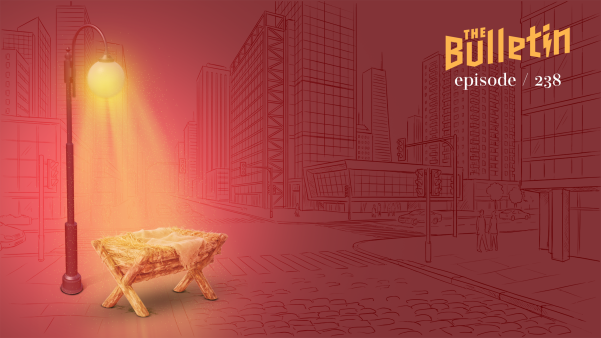Church kitchens are disappearing. They are disappearing from rural, suburban, and urban churches. From liberal and conservative churches, contemporary and liturgical, megachurches and the medium-sized.
One by one, across America, as buildings are remodeled and new construction replaces old, kitchens are getting scrapped.
No one tracks exact numbers—there’s no census of fellowship halls—but architects who specialize in sacred spaces told Christianity Today that the trend is hard to miss.
“I can’t remember the last time I was asked to design a big kitchen,” said Jacob Slagill, who teaches architecture at California Baptist University and designs church buildings for evangelicals. “A small kitchen, maybe.”
Newly built or remodeled churches typically have a space with a sink and a coffee pot, Slagill said. Possibly a microwave. But no expanse of countertop suitable for chopping carrots, potatoes, and onions to go into a big pot of soup. No oversized refrigerators for Jell-O salads. No industrial ovens large enough to cook three or four casseroles at once. Churches these days don’t have a lot of cupboards with drawers labeled “forks and knives,” “spoons,” and “serving utensils.”
That kind of space is gone. Or at least it’s going away.
A recent exhibit of religious architecture in the 21st century curated by architect Amanda Iglesias included more than 40 churches from around the world. Only five had dedicated spaces for gathering around food.
“Culture has changed,” said Katie Eberth, an architect with Aspen Group, a leading firm in the field of church design. “It’s not part of the culture now, the church culture, where you have 20 women who come together and make a meal. Today we order Panera or Jimmy John’s.”
When new clients sit down with Aspen architects, Eberth said, they don’t often ask for kitchens. They are most likely to start the conversation with their needs for more space, more parking, or more rooms for Sunday school and youth groups.
The architects ask them to set the specifics aside, for a moment, and have a larger conversation. One of the first questions Eberth likes to ask is “How do you define your community?” Then they start to talk about the vision for the church, their aspirations, and their congregation’s values.
Hospitality comes up a lot, according to Eberth. But when people talk about what that should look like in the physical construction of a building, they don’t talk about fellowship halls with long folding tables where everyone can sit together. They talk about a café serving coffee and pastries in the foyer.
“The lobby is becoming more important, because it extends people’s time at church, before and after a service,” Eberth said. “That’s where people—especially younger people and new people—are going to connect.”
If Aspen clients do talk about the possibility of a church kitchen at some point in the process, they are generally dissuaded by the cost, the additional permitting required by city and county governments, and the lack of volunteers. Who is going to work in the church kitchen?
Historian Gretchen Buggeln, author of Temples of Grace and The Suburban Church, said this part of congregational life has changed dramatically over the last 50 years, driven by larger cultural and economic transformation in America. In 1970, about a third of married women with children under 18 had jobs outside the home. By 1980, that had increased to 51 percent. By the 2010s, more than 70 percent of mothers were part of the US labor force.
“Churches don’t have people to run a kitchen,” Buggeln told CT. “You have to have at least half a dozen people who can show up and cook.”
In her research on church buildings, Buggeln found there were always some people who questioned the cost of kitchens. Women in the 1950s and ’60s frequently fought with building and finance committees, justifying kitchens’ expense and arguing for better equipment. Those women saw the kitchen as their domain. Decades later, when they talked to Buggeln about the physical building, they were more likely to talk about the kitchen than any other part of the church.
“They remembered working together,” Buggeln said. “What was important to them was the actual people working together in the kitchen to prepare food, getting to know each other through shared work. That’s going away now.”
The change is significant to us now, but most churches, for most of church history, have not had kitchens. The oldest known buildings dedicated to the purpose of Christian worship—in the ancient Middle East cities of Dura-Europos, Aqaba, and Megiddo—didn’t have kitchens, and neither did the great Gothic cathedrals of Europe, such as Notre Dame, Chartres, and Westminster Abbey. American Christians in the 1800s really liked picnics, packing food to eat after revivals, outdoor baptisms, and Sunday school socials. But they didn’t have kitchens.
The age of church kitchens didn’t really get going until rapid urbanization started in the 1880s.
“The city offered saloons, amusement parks, and pool halls, places designed to attract and corrupt young minds with fun,” historian Daniel Sack writes in Whitebread Protestants. “Churches were just one competitor in the free market of entertainment. . . . The church had to use every tool at hand, including food.”
Potlucks, youth group socials, and charity fundraisers became so important in congregational life that by the 20th century, it wasn’t uncommon for critics to say the social activities overshadowed anything sacred. Religion scholar Martin E. Marty, for example, said that for a lot of Christians in America, church life and “the machinery of church life, smoothly oiled, takes the place of the deity.”
Most congregations, however, saw social activities as outreach. Kitchens brought people into church, where they could be fed, body and soul.
Some Christians say that despite broad cultural changes over the last 140 years, church kitchens still do this. When architect Rick Archer sat down with a committee to talk about some renovations at his own church, Grace Northridge Anglican in San Antonio, the first thing he said was “Let’s do the kitchen.” The committee agreed.
Food serves an important function in the life of the congregation, Archer told CT, and the kitchen is also an emblem of the invitation to the altar.
“It’s so much at the heart of who we are as a people,” he said. “When we gather around a table for a meal, it’s an extension of the gospel.”
A bigger kitchen can be a means for Christians to love their neighbors. An Evangelical Free church in Blackduck, Minnesota, for example, developed a funeral ministry because it had a large kitchen.
“This is a rural community, way north,” said pastor Dwight Warden, who retired in 2023. “Funerals were a big thing, and people would come to town for funerals and need a place to come together. These were not necessarily members, or even churchgoers, but our church would serve them. The bigger kitchen made it possible.”
Blackduck Evangelical Free remodeled its kitchen in 2011, expanding a tiny older space and installing a large refrigerator, a dishwasher, three ovens, and lots of cabinets. It was a serious financial investment. But it created new opportunities for outreach.
The church started a monthly Monday night meal that connected the congregation with members of other churches and community groups, including a women’s bowling league. The space was used for birthdays and graduation parties. And in the spring, when everyone desperately needed to get out after a long winter, the church would host a Wild Game Feed, serving venison, buffalo, duck, grouse, or some other meat harvested by local hunters.
“A kitchen isn’t just for coffee and donuts, though we always had coffee and donuts after church,” Warden said. “The Wild Game Feed, we had 250 to 300 people come to that every year, and some of these are people who would never darken the door of a church.”
Other congregations have decided a big kitchen requires too much work, doesn’t serve their needs, or won’t help them serve their communities.
“A big fellowship hall . . . if it’s not in use, it just leaves the church feeling kind of empty,” Iglesias said. “A big kitchen can be limiting. Churches are living organisms, and the architecture needs to be living too. Churches adapt.”
Architects who specialize in sacred spaces told CT that adaptation might lead to more child care co-ops or coworking spaces in American churches. There could be renewed interest in designs that elicit feelings of awe, with extra emphasis on art and natural light.
In the past, church needs were met in the kitchen. But now, people seem hungry for something else.
Daniel Silliman is senior news editor at Christianity Today.














